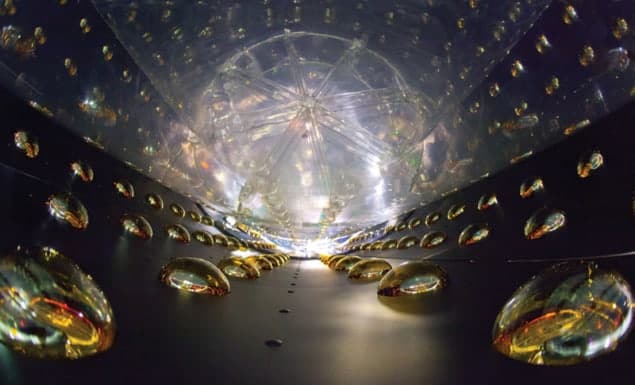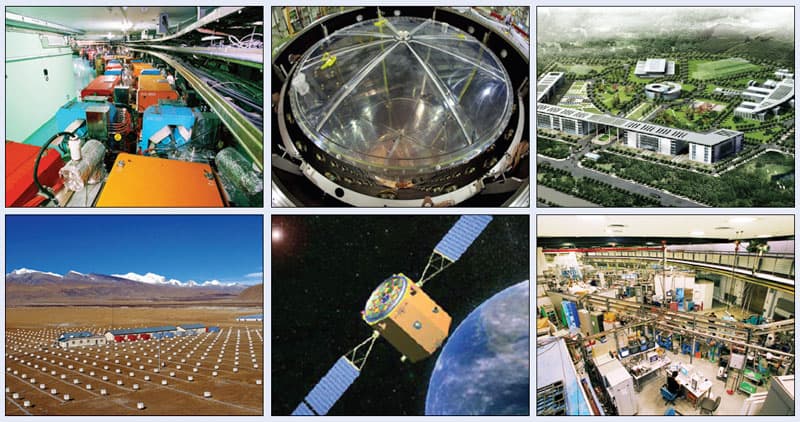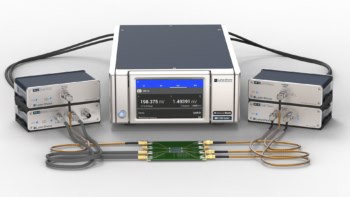China's Institute for High Energy Physics is one of the world's leading particle-physics labs and has just completed the first part of a major neutrino facility at Daya Bay in the south of the country. And as Matin Durrani finds out, the institute is also expanding into astronomy, neutron scattering and imaging science

Over a cup of green tea at the headquarters of the Institute for High Energy Physics (IHEP) in Beijing, Hesheng Chen, who has been its director since 1998, takes me through a list of the institute’s many current and planned research facilities. It is an impressive tally, including a huge neutrino experiment that has just begun taking data, a spallation neutron source being built in Guangdon in the south-east of China, an observatory in Tibet to study ultrahigh-energy cosmic-rays, and a 5 GeV advanced light source that will start being built in 2016 (see below). China also recently gave the go-ahead for a new ‘hard’ X-ray telescope that will also be run by IHEP (Physics World June p8, print edition only).
The facilities are testimony to the huge investment that China is currently making in fundamental physics – and to the know-how and ingenuity of Chinese researchers. IHEP’s first and perhaps best-known facility is the Beijing Electron Positron Collider (BEPC). It was originally approved in 1983, just as China was emerging from the long isolation of the Cultural Revolution. Indeed, so significant was the facility to the resurgence of science in the country that its ground-breaking ceremony in 1984 was attended by then Chinese vice-premier Deng Xiaoping, who later returned in 1988 when the BEPC began its first electron–positron collisions.
Located at the IHEP headquarters in the west of Beijing, about 15 km from Tiananmen Square, the collider originally had a 240 m-long ring of magnets that accelerated a single bunch of electrons and a bunch of positrons in opposite directions, colliding them with a luminosity of 1031 particles per square-centimetre per second. The collisions produced particles containing a charm quark and an anticharm quark, which decayed rapidly into other mesons. Using the 500-tonne Beijing Spectrometer (BES) to measure the energy and momentum of this debris, IHEP researchers were able to pin down various properties of the parent charmed particles, including the J/ψ.
Not resting on its laurels, a major upgrade to the collider was completed in 2008. BEPC-II, as the facility is now known, has an additional ring that allows electrons and positrons to be accelerated separately. Up to 93 bunches can now be fitted into each ring, which has meant that researchers can produce collisions with, so far, a 65-fold increase in luminosity. ‘We now collect as many data in one day as in about 80 days before,’ says Chen, who underlines the fact that the upgrade was completed on time and within budget of ¥640m (about $100m). The facility has also benefited from a redesigned detector, dubbed BES-III, that uses stronger superconducting magnets to allow the energy and momentum of the collision debris to be measured with higher precision.
Spreading their wings
But BEPC-II is of interest to more than just particle physicists; for three months each year synchrotron radiation from the collider is siphoned off and sent along 14 beamlines for studies in everything from condensed-matter physics and nanotechnology to biomedicine and the life sciences. Chen says that researchers from some 100 institutions across China carry out more than 500 experiments each year at what is dubbed the Beijing Synchrotron Radiation Facility, which produces bright beams of light ranging from the ultraviolet to short-wavelength ‘hard’ X-rays. Medical scientists from the University of Shanghai, for example, have used it to study, at a molecular level, various aspects of traditional Chinese medicine, including why otherwise poisonous arsenic-containing compounds are used to treat leukaemia (Science 328 240).
Chen believes that the upgrade to the BEPC has helped IHEP’s researchers to really stretch their wings, as has the construction of the 2.5 GeV Shanghai Synchrotron Radiation Facility, to which they also contributed. ‘We have a good, capable and young team that I believe can develop still further,’ he says. One new project that is certainly keeping Chen’s staff busy is the Daya Bay Reactor Neutrino Experiment, which is currently being built in the mountains close to the Ling Ao and Daya Bay nuclear reactors in southern China about 55 km north-east of Hong Kong. A collaboration between 19 Chinese and 16 US universities, the experiment is designed to measure θ13 – one of three ‘mixing angles’ that characterize how neutrinos transform, or ‘oscillate’, from one type to another.
When fully complete next year, the new neutrino facility will consist of three experimental halls that contain identical neutrino detectors, each filled with 20 tonnes of gadolinium-doped liquid scintillator. When an electron antineutrino from the reactors strikes the liquid, a flash of light is produced that is then picked up by a bank of photomultiplier tubes around the liquid. The first experimental hall, which is around 300 m from the Daya Bay reactor, opened in August, while the second experimental hall – 500 m from the Ling Ao reactor – is expected to be finished by the end of this year.
Both halls are 100 m underground, where the overhead rocks shield them from unwanted cosmic rays, and each contains two so-called near detectors to characterize the beam of electron antineutrinos. A third hall, about 2 km away from both reactors and 300 m below ground, will be ready by June next year. Containing four neutrino detectors, it will measure the electron-antineutrino beam that has passed through the near detectors, so that any drop in the strength of the signal will be an indication of neutrino oscillation.
‘Among the current generation of reactor neutrino-oscillation experiments for measuring θ13, Daya Bay has the best sensitivity,’ says project co-spokesperson Kam-Biu Luk from the Lawrence Berkeley National La- boratory in the US. What also makes Daya Bay so special for physics in China is that it is the biggest scientific facility built in the country through a genuine international collaboration. Although China has enjoyed a formal collaboration with France on particle physics, accelerators and related technology since 2007, this time the US – through its Department of Energy – is actually stumping up cash to build something new on Chinese soil.
The US is paying $34m – about half the cost of the detector – with China paying the same and all of the civil-engineering costs. Indeed, Luk expects that the facility will prove to be a good testing-ground for more partnerships between the two countries. ‘Daya Bay provides a unique opportunity to join forces to tackle a burning question in neutrino physics and, more importantly, to learn how to work together,’ he says.
Talent seekers
With about 50 IHEP staff currently being dispatched south to Daya Bay for shifts lasting three to six months – and with the institute also working on so many other facilities – Chen admits that finding enough good-quality staff to fulfil the institute’s grand plans is not always easy. ‘No other particle-physics lab in the world has so many projects going on simultaneously, so we are under a lot of pressure,’ he says. ‘We do make some special offers to qualified Chinese physicists working overseas and many do return home, but it is not enough.’
And if all that was not enough, IHEP researchers are also contributing to a trio of other projects. One is the Franco–Chinese SVOM (Space-based multi-band astronomical Variable Objects Monitor) mission to detect gamma-ray bursts, which will launch in about 2016. A second involves research into using accelerators to reduce the half-life of radioactive nuclear waste via ‘nuclear transmutation’, while the third sees IHEP staff building an X-ray spectrometer that could go on China’s upcoming Chang’e 3 mission to the Moon, which is due to take off in 2012.
IHEP scientists are also involved in the Large Hadron Collider at the CERN particle-physics lab near Geneva, with about 20 staff and PhD students working on each of the ATLAS and CMS general-purpose detectors. ‘We have built many components for both detectors,’ says Chen, including ‘end-cap’ muon chambers, about a third of which were designed and constructed in Beijing. There is also a remote-operations centre in Beijing, where physicists are busy analysing the latest CMS data arriving from CERN.
Indeed, IHEP has long played a pioneering role in information technology in China, with the lab getting the country’s first Internet connection in 1986. In fact, until the mid-1990s, Chen recalls, many foreign companies and embassies in Beijing still used the IHEP Internet service to connect to the Web.
More money needed
Although heaping praise on the Chinese government for ‘significantly’ increasing its support for science and technology over the last 15 years, Chen points out that this was from a very low level – and that much more investment is needed. Indeed, China still ploughs only about 1.9% of its Gross Domestic Product (GDP) into research, which is less than the likes of Japan and France. That figure might not seem too bad, given that it is only slightly below the target of 2.0% that the country wanted to reach by 2010, but the absolute investment in science is relatively small for a country the size of China, given that, in terms of GDP per head of population, it is only about 100th in the world. ‘We still need to ask the government to increase its investment in basic research,’ says Chen.
One facet of China’s surge in scientific productivity has, however, left a sour taste in Chen’s mouth – the overemphasis on researchers publishing papers, many of questionable quality. ‘I am certainly not satisfied with the quality of papers in China,’ Chen admits. ‘The reasons for the focus on papers is complex, but it is not helped by the fact that every PhD student has to publish a paper before they defend their thesis – in fact the requirement in theoretical particle physics is that they publish two. I don’t think that is the right way to judge people. In accelerator science, for example, building a good component ought to be just as good as writing a paper.’ Although IHEP itself does not evaluate its staff on the number of papers published, Chen admits it is relatively unusual in that regard.
Looking ahead, one project that Chen categorically says will not be built on Chinese soil is the International Linear Collider (ILC), which is a blueprint for the next big accelerator project in particle physics after the LHC. (It is competing with a rival plan from CERN, known as CLIC.) ‘We have more than enough on our plates without building the ILC in China,’ laughs Chen, who is on the collider’s international steering committee, although interestingly IHEP does have about 10 people working on the ILC design. ‘Hosting the ILC would be very complicated and at the moment it’s not a high priority,’ he says. ‘I just don’t think in the near future that China can make what would be a huge investment.’
IHEP facilities
The Institute for High Energy Physics of the Chinese Academy of Sciences employs about 1300 staff, of whom about two-thirds are physicists and engineers, and in addition also has more than 500 PhD students and postdocs. It either runs or is building a range of scientific facilities, including the above.




